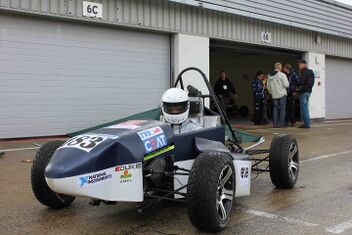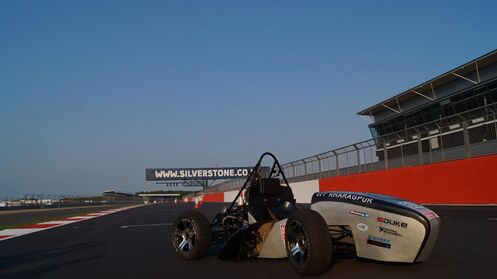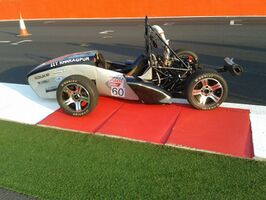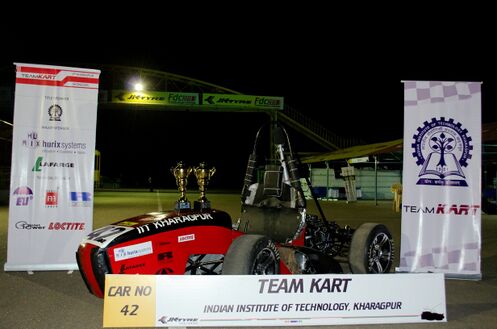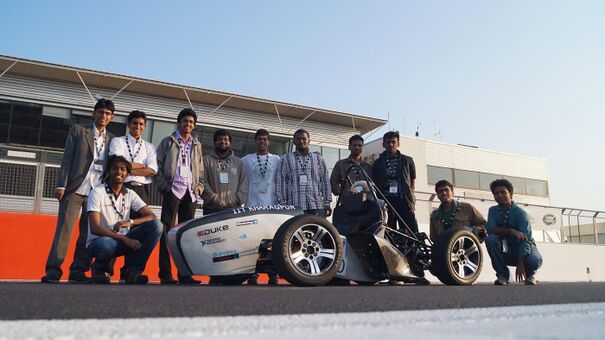Engineering:Team KART
| Base | Kharagpur, India |
|---|---|
| Faculty Advisor | Prof. A.R. Mohanty Prof C.S. Kumar |
| Team Leader | Tushar Patle |
| Deputy Team Leader | Aastha Sharma |
| Finance Head | Sumit Adwani |
| Website | www |
| Formula Student UK 2013 | |
| Chassis | Tubular Seamless Carbon Steel |
| Engine | KTM 390 Duke (single-cylinder 373.2cc) |
| Tyres | Hoosier 13 x 6.0-2.5 |
| Formula Student UK | |
| Debut | 2010 |
| Latest race | 2019 |
| Competitions competed | Formula Student UK (3) , Formula Design Challenge 2015, Formula Bharat 2017, Formula Bharat 2019 |
Team KART is a group of students from Indian Institute of Technology Kharagpur who like to explore the practical side of automotive engineering.
Team KART is officially a sponsored research project under the Sponsored Research and Industrial Consultancy Cell (SRIC) and the department of Mechanical Engineering, IIT Kharagpur. The team designs, fabricates, manufactures and tests Formula Style race cars and represents IIT Kharagpur at various National and International events like Formula Student (UK), Formula Student Russia and Formula Design Challenge India.
History
Its foundation was laid in 2008. It was an outcome of efforts of few enthusiastic founding members and faculty advisers. The team took a solid form with the support of Prof. PP Chakraborty (former Director, IIT Kharagpur) and Prof. Sunando Dasgupta (former Dean SRIC, IIT Kharagpur). Sidhartha Khastgir became the first team leader and steered the team through the difficult initial stages where the team faced a shortage of funds and technical knowledge. Since then it has grown to become IIT Kharagpur’s largest student project encompassing around forty students from ten departments. Ganesh Kumar M. became the second team leader and held responsibility for three years and oversaw the development of K-1 and K-2.
To date, the team has successfully made seven cars - KX-1, K-1, K-2, K-2.2, K-3, K-4 and K-5. K-2 competed at Formula Student UK 2013. Several design oversights in K2 were fixed in K-2.2 by a new chassis and intake-exhaust system; which competed at Formula Design Challenge 2015. K-3 participated in Formula Bharat 2017. And K-4 participated in Formula Bharat 2019.
Formula Student
Formula Student (FS) is Europe's most established educational motorsport competition, run by the Institution of Mechanical Engineers (IMechE). Universities from across the globe are challenged to design and build a single-seat racing car in order to compete in static and dynamic events, which demonstrate their understanding and test the performance of the vehicle. The format of the event is such that it provides an ideal opportunity for the students to demonstrate and improve their capabilities to deliver a complex and integrated product in the demanding environment of a motorsport competition.
Formula Bharat
Formula Bharat is an engineering design competition in which students from colleges and universities all over India, compete with a life-size Formula-style vehicle in areas of engineering design, overall cost, marketability, and dynamic performance. Being identical to the global student hosted in around eleven countries per year, the event encourages students to gain hands-on practical experience, while applying engineering theories studied in the classroom. It is hosted and managed by Mobility Engineering Consortium Pvt. Ltd., an organization dedicated towards hosting mobility-related competitions for students.
Cars
KX-1
The KX-1 was the team's first effort to build a car. The 'X' in the name stands for an experiment as the car was the very first attempt of our complete novice team. The car was powered by a Honda CBR600RR engine which has henceforth powered all the cars prior to the K-3.
The team participated in Formula Student, UK 2010. The participation was however limited to static events. The team stood ninth in the cost report analysis, as the car was very cost effective in its design. The team was one of the six teams to be nominated for the Airbus Teamwork Award.
K-1
The K-1 was a major leap forward for the team. It was improved many folds from the first car. The car was powered by a Honda CBR600RR engine just like its predecessor.
The team participated at Formula Student, UK 2011 with the car. However, the team was restricted to participate only in the static events as the car had failed to clear the stringent scrutiny tests before the dynamic events. But impressive performance in the static events saw team becoming one of the top three rookie teams at the event. The team again became one of the six teams to be nominated for the Airbus Teamwork Award.
| General |
|
| Chassis |
|
| Engine |
|
| Steering & Suspension |
|
| Brakes |
|
K-2
With a new car, K-2, the team participated at Formula Student, UK 2013. The car was powered by a Honda CBR 600 engine just like its predecessors. There was significant improvement in the car, a new plenum had been designed and manufactured in–house in rapid prototyping for better intake. New and more efficient SLA suspensions were implemented.
It was the team's most successful visit yet with the team clearing all the six scrutinizing inspections namely tech, safety, chassis, noise, brake and tilt, as per the rules & norms governed by the MSA (Motor Sport Association) and SAE (Society of Automotive Engineers). Out of the six Indian teams, Team KART were one among the two teams to qualify for the dynamic events. The team competed in the endurance test. The team managed to secure 43rd position in Business Presentation and 45th in Cost and Sustainability Design Report and stood 67th overall among 120 participating teams.
| General |
|
| Chassis |
|
| Engine |
|
| Steering & Suspension |
|
| Brakes |
|
| Transmission |
|
K-2.2
The K-2.2 was the upgraded and improved version of K2. The car was powered by a Honda CBR 600RR engine. A consequential improvement could be seen in the car. A new impact attenuator was added and the intake diffuser, throttle body and air filter had been changed. Another addition to the K2.2 was the new Scorpion Carbon fibre muffler, which was the first carbon fiber part of the car. The size of the radiator fan had also been increased for better performance.
The team participated in Formula Design Challenge 2015 and passed technical scrutiny. Although a seized engine prevented the team from taking part in the dynamic events, nonetheless it was a great learning experience for the whole team. The team bagged the first runners up position in Business Presentation and Cost Report, second in Business Plan Presentation & second in Cost and Manufacturing Report.
| General |
|
| Chassis |
|
| Engine |
|
| Steering & Suspension |
|
| Brakes |
|
| Transmission |
|
K-3
K-3 improved upon its preceding models by leaps and bounds. Several innovative designs were successfully implemented like data acquisition, digital display and wireless telemetry. K-3 has carbon fiber reinforced parts which include body panels and mufflers. K-3 has its Topology optimized suspension aluminum uprights weighing 950g each. The car boasts of its new 3-D printed ABS plastic intake. The team successfully performed its engine tuning through PowerTronic ECU.
The Team participated in Formula Bharat 2017 and were one of the few teams to clear the technical inspection round. The Team stood second in the Business Presentation event during the competition and stood 6th in the Rulebook quiz. The event was overall a great learning experience for the team.
| General |
|
| Chassis |
|
| Engine |
|
| Steering & Suspension |
|
| Brakes |
|
| Transmission |
|
K-4
In order to keep up with the fast-paced action and innovations of the FSAE circuit, it is important that we work to better ourselves with every car that is manufactured.
An innovative FS car should be sleek, light-weight, fast and efficient. Our latest car K4 checks off all those boxes, considering that it is one of the lightest and fastest cars we have manufactured since inception. It also boasts of several new upgrades that have added a sense of accomplishment to our car.
Powertrain
K4 has a 3D printed (chemically welded) side intake which helped us to reduce the overall weight of the car. For the first time, K4 underwent dyno-tuning at a facility in Bengaluru which resulted in better power output and greater fuel efficiency. Eccentric differential mounts were installed which helped in chain tensioning and further reduced the weight.
Chassis
The acceleration and performance of the car improved as we successfully reduced the chassis weight by 10 kg as compared to our previous car K3. This was achieved with the proper usage of AISI 4130 mild steel over the AISI 1080 version. Moreover, extensive work into triangulation enabled us to design a smart and efficient structure.
Aerodynamics
K4 has been made by implementing our Team’s first aerodynamic package element, the under-body diffuser.
| General |
|
| Chassis |
|
| Engine |
|
| Steering & Suspension |
|
| Brakes |
|
| Transmission |
|
K-5
K-5 is by far the most successful project and the best car in terms of design in the team's history. With K-5 the team was able to give their best performance so far. The team bagged several accolades in the competition Formula Bharat 2020 namely, 2nd in Business Plan Presentation & 6th in Engineering design event. Also, the car was the second one out of just three to clear mechanical scrutiny on the 1st day itself and cleared the tilt test as well. The team also proved its mettle in the dynamic events owing to its highly trained and experienced drivers. There were several additions from the design perspective of the car in comparison to the previous car. The team installed a bunch of sensors to track and validate their design and was successful in achieving telemetry to a local host computer. The team was also commended for its innovative methods to measure RPM and wheel speed.
| General |
|
| Chassis |
|
| Engine |
|
| Steering & Suspension |
|
| Brakes |
|
| Transmission |
|
Team structure
Team KART comprises undergraduate students from first to the fifth years
- Team Mentors: 4th & 5th years
- Team Leader: 3rd year
- Team Managers: 3rd year
- Sub Team Head: 3rd year
- Team Member: 2nd year
- Trainee: 1st year
Subsystems
- Suspension and Brakes
- Chassis and Aerodynamics
- Engine
- Intake and exhaust system
- Engine electronics team
- Fuel and cooling system
- Transmission and drivetrain
- Corporate & public relations
- Electronics
Citations
- https://www.iitkgp.org/index.php/news/kgp-in-spotlight/1005-team-kart-success-saga-continues-in-the-3rd-consecutive-year[no|permanent dead link|dead link}}]
- https://www.iitkgp.org/index.php/news/kgp-in-spotlight/552-team-kart-at-formula-student-2010[no|permanent dead link|dead link}}]
- http://education.oneindia.in/news/2013/06/14/iit-kharagpur-student-team-at-fsae-2013-005403.html
- https://web.archive.org/web/20130804012908/http://www.gymkhana.iitkgp.ernet.in/student-activities/initiatives/
- https://web.archive.org/web/20130926214615/http://www.100marks.in/News/formula-1-racing-car-%E2%80%98kart%E2%80%99-designed-by-iit-kgp-students-ready-to-compete-with-professional-f-1-cars/
- http://www.racecar-engineering.com/cars/kharagpur/
- http://ashwathicr.blogspot.in/2013/06/iit-kharagpur-student-team-at-fsae-2013.html
- https://web.archive.org/web/20130812071205/http://www.coolage.in/2013/08/08/students-excel-at-international-formula-student/
- https://teamkart.org/
External links


